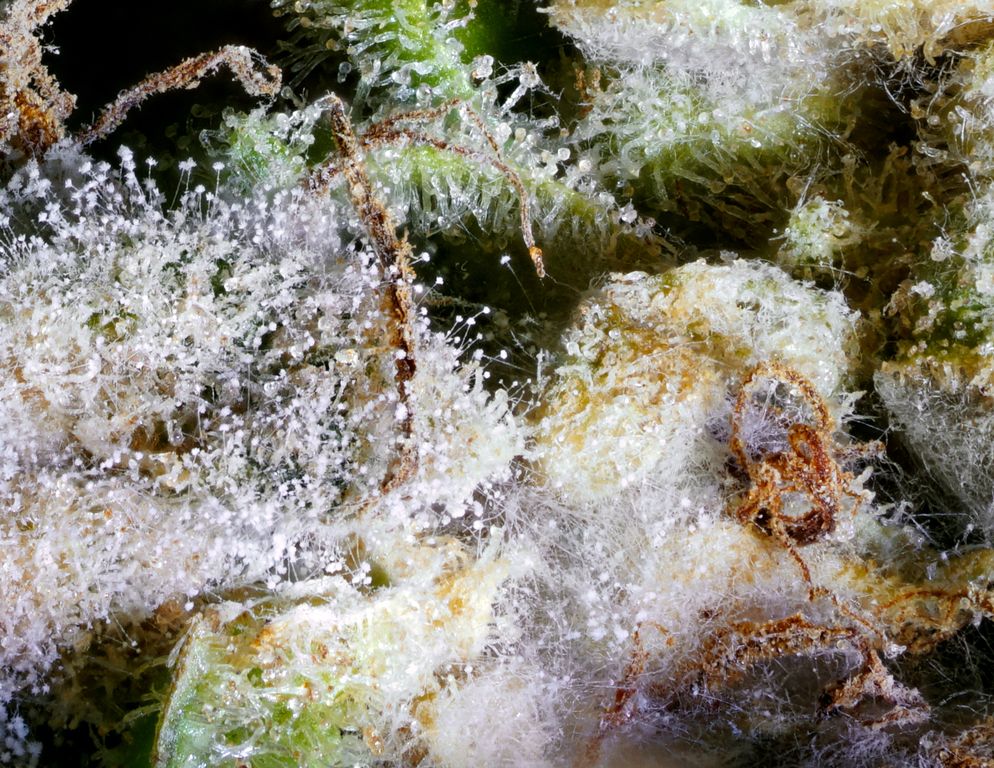Botrytis
Botrytis, also known as "Bud Rot” or gray mold is a pathogen that typically affects many plant species, but its most notable hosts are wine grapes and cannabis.
According to Penn State University,1 “Botrytis is a pathogenic fungus found virtually everywhere plants are grown.”
Botrytis spores can be found on live plant material and can remain dormant on plant surfaces for extended periods of time. In order for the pathogen to take hold, there must be a vulnerability in the plant, as well as a conducive environment.
Quality of air (circulation and ventilation) and morphogenesis of the plant (flower density and configuration) are the two biggest contributors to Botrytis. In other words, Botrytis relies heavily on a conducive environment and a susceptible host.

The flower morphogenesis makes all the difference in Botrytis resistance.
Anaerobic environments with high moisture pockets are the most conducive to Botrytis. Large, dense buds that stack heavily with a stocky structure are the most likely to have these pockets where air cannot circulate properly through the buds—allowing moisture to build up.
I had a Grandpa’s Cookies flowered from seed that I had to cut a week early because we knew it was going to rot. You could look at it and see it was going to rot because it was stacked so thick that the apex of the plant could not properly transpire. The pheno right next to it looked slightly different and it was fine because air was able to infiltrate the buds a little better.
The flower morphogenesis—how the buds literally stack, how a plant stacks at the very top, how much airflow is getting to the inside of the flowers—makes all the difference in Botrytis resistance.
There are also varieties that are prone to Botrytis because of lower resistance, which can be improved through breeding over time. With directional breeding, this vulnerability can be dramatically mitigated. When working a genetic line, in addition to selecting plants for desirable flower qualities—such as yields, trichomes and bract-to-leaf ratio—select for pathogen resistance.
In a directional program, you can focus on pathogen resistance as the primary expression. Plants with buds stacked with proper space to breathe and a greater distance between internodes will be more resistant to Botrytis. Selecting these plants to breed future filial offspring can reduce vulnerability.
A clean grow with proper air circulation—distribution within the room—and ventilation is a must, especially if your plants are prone to Botrytis. Botrytis begins with dying tissue, because it requires access to a plant’s nutrients in order to thrive. Dying tissue anywhere on the plant can become a breeding ground for spores.
Botrytis starts as a white or gray growth that will transition to a dark, brownish “rotten” appearance in affected tissue.
If the air is not being properly conditioned, circulated, and exhausted, the problem will rapidly intensify. Moisture builds up inside the buds and spores find their way throughout the grow, and these moist, anaerobic environments encourage fungal growth.
Botrytis starts as a white or gray growth that will transition to a dark, brownish “rotten” appearance in affected tissue. The more nutrients the pathogen can absorb, the stronger it will become. Once it feeds off of unhealthy tissue, it will begin attacking healthy parts of the plant as it continues to feed.
Removing affected tissue is essential to preventing the spread. If you notice Botrytis on your plants, sanitize the affected buds and work to increase airflow in your colas.
Start by sanitizing the affected buds as best you can to avoid spreading the spores further and then remove them. You can use a sanitizing solution of Zerotol 2.0 and water (37ml/gallon with nonionic surfactant like Natural Wet). Botrytis grows from the inside out, so start by using this sanitizer on the stem to address any spores there.
I recommend using a technique that involves a bent popsicle stick. Bend an extra-large popsicle stick—you can find them in arts and crafts aisles—to the point where it breaks. Use half of the stick to prop open the bud structure, spread the buds out and increase airflow. This is a technique used in California and many outdoor grows as a non-chemical approach to saving crops.
Pathogens alone are not enough to create an infestation, but a susceptible host and a conducive environment left unaddressed can turn a small issue into a big problem.
If you’re able to quickly recognize the signs of Botrytis—and take steps to sanitize and prevent spread—your plants will thank you.
—
SOURCES:
1. Moorman, Gary W. “Botrytis or Gray Mold.” Penn State Extension, 12 June 2014, https://extension.psu.edu/botrytis-or-gray-mold.
Subscribe to our Substack to receive new content automatically
This article is featured in Vol. 3 of The ETHOS Magazine.
Grab a collector's edition of the ETHOS magazine in print HERE.